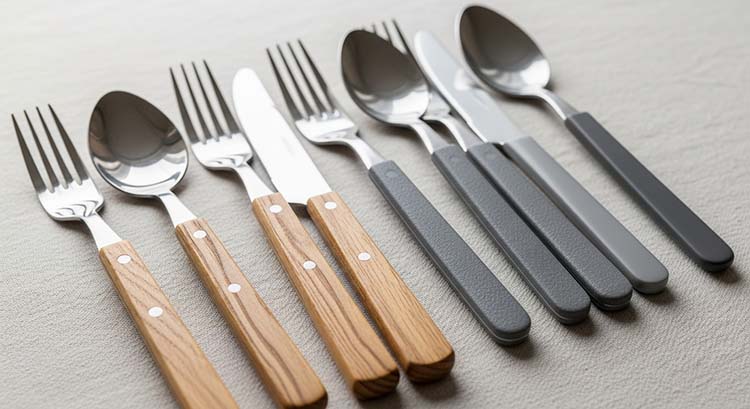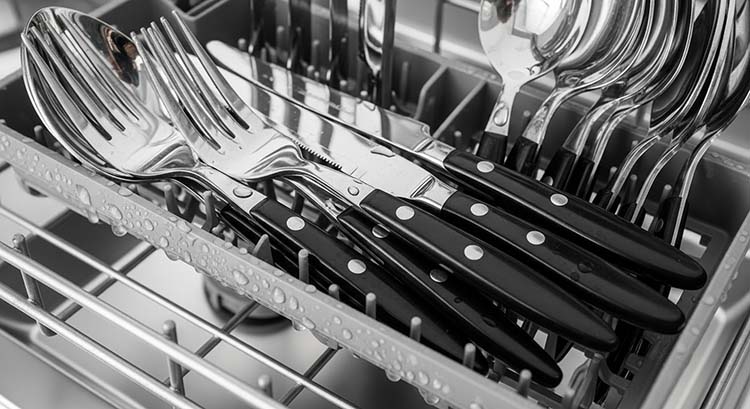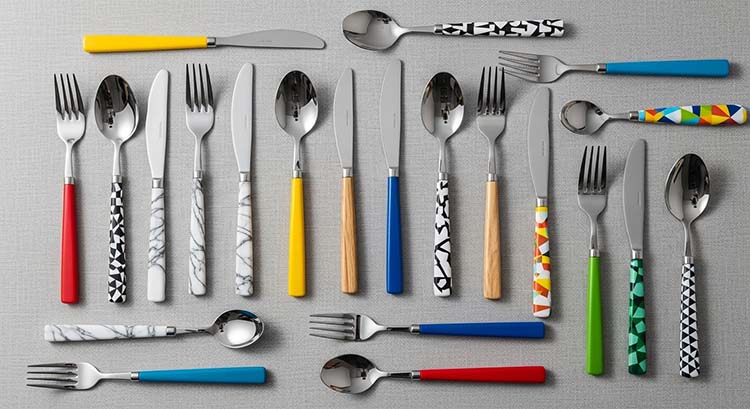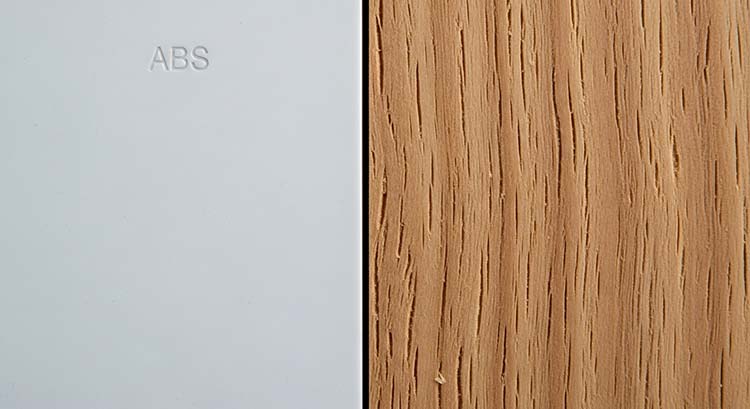Wooden vs. ABS Handle Cutlery: Which is right for you?
Choosing cutlery with handles can be confusing. The wrong choice leads to cracked handles, hygiene issues, or a style that just doesn't fit your table, costing you time and money.
Choose wooden handles for a classic, natural look, but know they require handwashing. Opt for ABS plastic handles for unmatched durability, design variety, and easy dishwasher-safe cleaning, making them ideal for high-use settings.

A few years ago, I had two clients with opposite needs. One was opening a rustic farm-to-table restaurant and wanted everything to feel natural and authentic. The other was launching a chain of modern, funky cafes and needed flatware that matched their bright brand colors. For the restaurant owner, we chose a beautiful ash wood handle. For the cafe chain, we developed a custom-colored ABS handle. Both were happy because they chose the material that fit their story. Your choice is just as important, so let's break down the pros and cons of each.
How Do Wooden and ABS Handles Hold Up to Daily Use?
You're tired of cutlery handles cracking, fading, or falling apart. It is expensive and frustrating to have to replace whole sets of flatware so frequently.
ABS handles are extremely durable, impact-resistant, and completely dishwasher-safe. Wooden handles are beautiful but much more delicate, requiring careful handwashing to prevent cracking, absorbing moisture, and potential mold.

When we talk about durability, we are really talking about how a material handles water, heat, and impacts. Here, ABS plastic is the clear winner for a low-maintenance life. It's a tough, stable plastic that can withstand drops, knocks, and the high heat and harsh detergents of a commercial dishwasher without losing its color or shape. I have clients who have used our ABS handle cutlery in busy restaurants for years, and they still look great. Wood, on the other hand, is a natural material that needs a lot more care. It is an enemy of the dishwasher. The intense heat and prolonged moisture will cause the wood to swell, crack, and eventually break or fall off. It can also absorb odors from food. To keep a wooden handle looking good, you must hand-wash it and dry it immediately. It's a commitment.
| Durability Factor | ABS Plastic Handle | Wooden Handle |
|---|---|---|
| Dishwasher Safe | ✔️ Yes | ❌ No |
| Impact Resistance | High | Low (can crack) |
| Moisture Resistance | High (non-porous) | Low (porous, can swell or mold) |
Which Handle Offers More Design Options?
Your all-steel flatware feels a bit boring. You want something that adds a pop of personality to your table, but you're not sure what options are available.
ABS handles offer almost infinite design flexibility. They can be made in any color or with custom patterns like marble or wood grain. Wooden handles offer a timeless, natural beauty but are limited to the look of the wood itself.

This is where ABS1 really shines. As a manufacturer, I love working with ABS because it is like a blank canvas. Do you want your flatware handles to match your brand's specific Pantone color2? We can do that. Do you want a sophisticated black matte finish? Easy. How about a realistic-looking oak wood grain3 or a chic Italian marble pattern? We can do that too. This versatility allows brands to create truly unique products that stand out. I recently worked with a hotel that wanted a subtle tortoiseshell pattern for their bar's cutlery, and ABS made it possible. Wood offers a different kind of beauty – an authentic, natural one. Each piece is unique because of the wood grain. You can choose different types like light-colored ash, warm walnut, or rich olive wood. However, you are ultimately limited by what nature provides. This is perfect for a specific aesthetic, but less flexible if you need to match a specific color palette.
Are Wooden and ABS Handles Safe and Hygienic?
You worry that germs could be hiding on your cutlery handles. The idea of bacteria building up on a surface that you touch during every meal is a serious concern.
ABS is a non-porous plastic, which makes it extremely hygienic and easy to sanitize in a dishwasher. Wood is naturally porous; over time, it can develop micro-cracks that may harbor bacteria if not cleaned and dried perfectly.

From a food safety perspective, especially in a commercial setting like a restaurant, this is a critical difference. The head of the stainless steel part of the cutlery is always made from food-grade steel, so that part is safe. The handle is the main point of difference. The surface of an ABS handle is solid and smooth. There are no tiny holes or pores for food particles or bacteria to hide in. You can wash it at high temperatures in a dishwasher, which effectively sterilizes it. This is why you see it used widely in professional environments. Wood is a beautiful material, but its porous nature is a disadvantage for hygiene. If it's not cared for perfectly, it can absorb moisture, which can lead to bacterial growth or even mold inside the material. Tiny cracks can form over time, creating more places for germs to hide. This is why many health departments are very strict about using wooden utensils in commercial kitchens. For home use, if you are diligent about handwashing and drying, it can be safe. For restaurants, ABS is the safer bet.
How Do You Match Handle Cutlery to Your Table's Theme?
You've spent a lot of time choosing the perfect plates and glassware. Now you need cutlery that completes the look instead of clashing with it.
Match the material to the feeling you want to create. Wood is perfect for rustic, natural, or farmhouse themes. Versatile ABS handles are ideal for modern, retro, brand-specific, or colorful table settings.

The handle on your cutlery is a powerful design tool. It's an opportunity to reinforce your theme. Think about the story your table is telling. If your restaurant is all about organic, farm-to-table food with reclaimed wood tables, wooden handle cutlery is the perfect choice. It connects directly to that natural, earthy feeling. Even the fact that it is not perfect and requires care can be part of that authentic story. Now, imagine a different scene: a minimalist, modern cafe with a black-and-white theme. A set of cutlery with a matte black ABS handle would look sharp, clean, and intentional. Or think of a fun, family-friendly diner. Cutlery with retro-colored pastel ABS handles would add a playful touch. Because ABS can be made in any color or pattern, it can be tailored to fit almost any theme imaginable.
| Table Theme | Recommended Handle | Why it Works |
|---|---|---|
| Rustic / Farmhouse | Wood | Natural, warm, and authentic feel. |
| Modern / Minimalist | ABS (Black, White, Grey) | Clean lines, sleek, sophisticated look. |
| Retro / Playful | ABS (Pastels, Bright Colors) | Fun, vibrant, and adds a pop of color. |
| Branded / Corporate | ABS (Custom Color/Pattern) | Matches brand identity perfectly. |
Conclusion
Choose wood for its natural beauty if you're committed to its care. Choose ABS for its unmatched durability, design freedom, and easy maintenance. The right choice depends on your style and practical needs.
-
Explore the advantages of ABS in manufacturing, including its versatility and customization options for unique product designs. ↩
-
Exploring this resource will deepen your understanding of how Pantone colors enhance branding and product aesthetics. ↩
-
Discover how different wood grains contribute to the beauty and uniqueness of products, enhancing their appeal and value. ↩
